
Western Plunge Remains Open at Depth and Along Strike, Demonstrating Strong Continuity
Highlights:
- Western Plunge Copper-Gold Zone Expands – 150 m Step-Out
- Hole 1274-25-373W1: 3.2m @ 8.16% CuEq (6.26% Cu, 2.21 g/t Au) within 11.0m @ 3.93% CuEq (2.92% Cu, 1.17 g/t Au).
- Confirms strong growth potential and a meaningful increase in potential resource footprint.
- Zinc-Silver VMS Zone Expands – Up to 225 m & New Western Copper-Gold Discovery
- Hole 1274-25-371W1: 7.2m @ 2.29% CuEq (3.56% Zn, 166.81 g/t Ag) Expansion of the VMS Zinc-Silver Zone.
- Identification of a new Copper-Gold zone ~300 m west of the current model.
- Drilling demonstrates exciting continuity and expansion in multiple mineralized horizons.
- B26 System – Expansion Continues Along Strike and Depth
- Step-out drilling confirms mineralization remains open in all directions, reinforcing the scale and continuity of the system.
- Ongoing results continue to demonstrate strong growth potential across both copper-gold and zinc-silver horizons.
- Momentum Building — Fully Funded Growth Ahead
- 16,990m of 20,000m Phase 3 program completed; additional assays pending.
- Fully funded through 2027, with a 20,000m Phase 4 program planned for 2026 to drive further value creation.
London, Ontario–(October 30, 2025) – Abitibi Metals Corp. (CSE:AMQ) (OTCQB:AMQFF) (FSE:FW0) (“Abitibi” or the “Company“) is pleased to report new assay results from its ongoing Phase 3 drill program at the B26 Polymetallic Deposit (“B26” or the “Deposit“) in Québec. Results have significantly expanded the high-grade Western Copper-Gold Zone, confirming strong continuity with a 150-metre step-out that intersected some of the best grades returned to date. The results continue to demonstrate growing expansion potential at B26, which remains open at depth and along strike. To date, 16,990 metres of the 20,000-metre Phase 3 program have been completed, with remaining drilling scheduled for completion by the end of November. Abitibi currently owns 50% of B26 and retains the option to earn an additional 30% from SOQUEM Inc., a subsidiary of Investissement Québec (see news release dated November 16, 2023).
Jonathon Deluce, CEO of Abitibi Metals, commented: “These latest results mark a very significant milestone for Abitibi Metals. The 150-metre step-out confirms that B26 has the grade, scale, and continuity to become a cornerstone copper-gold asset in Québec. We’re now seeing consistent growth across multiple zones, from high-grade extensions in the west to expanding zinc-silver horizons at depth, all pointing to a much larger system than previously defined. With strong momentum, further assays expected, and a fully funded path through 2027, we’re positioned to continue to showcase why B26 is one of Canada’s next standout critical-minerals projects.”
Louis Gariépy, P.Geo., Vice President Exploration of Abitibi Metals, commented: “Geologically, these results reinforce our understanding that B26 hosts a robust, multi-phase mineralized system. The 150-metre step-out confirms that the Western Copper-Gold Zone maintains strong grades at depth and along plunge, while new drilling into the VMS horizon continues to extend zinc-silver mineralization well beyond the existing resource model. The discovery of copper-gold mineralization 300 metres west of the block model, within the same alteration signature as the main deposit, suggests the system remains open laterally to the west and at depth. Every metre drilled is adding confidence and scale to what is shaping up to be a large mineralized footprint.”
To recap, Phase 3 is a fully funded drilling program designed around three strategic objectives:
- Expansion of High-Grade: Drilling continues to expand higher-grade zones at B26, driving resource growth in the block model. The latest results, led by standout hole 1274-17-269W3, reaffirm the strong momentum of the program and underscore the exceptional strength of the B26 mineralization. As highlighted in the October 9, news release, drilling continues to deliver impressive grades, including 4.46% CuEq over 21.1 metres from hole 269W3.
- Expansion of Mineralized Trends: Extending open-ended mineralized trends beyond the current B26 in various directions of the block model is one of the primary goals of today’s drill results.
- Unlocking Regional Potential: making new discoveries across Abitibi’s 3,328-hectare property is set to become the next focus in Q1 2026.
The results from these holes further validate the continuity of mineralization at depth along the down plunge of the western Cu-Au mineralized shoot within the current resource model of 11.3MT @ 2.13% Cu Eq (Indicated- 1.23% Cu, 1.27% Zn, 0.46 g/t Au and 31.9 g/t Ag) & 7.2MT @ 2.21% Cu Eq (Inferred – 1.56% Cu, 0.17% Zn, 0.87 g/t Au and 7.4 g/t Ag). The company anticipates these results to positively contribute to the expansion of its mineral resource base.
Table 1: Significant Intercepts from Phase 3
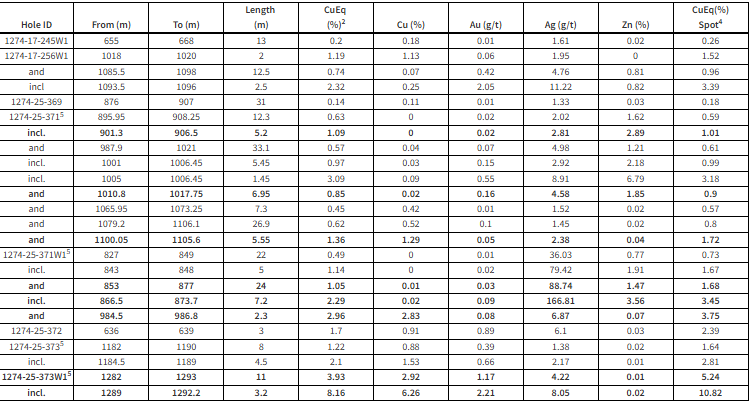
Note 1: The intercepts above are not necessarily representative of the true width of mineralization. The local interpretation indicates core length corresponding generally to 60 to 90% of the mineralized lens’ true width.
Note 2: Copper equivalent values calculated using metal prices of $4.00/lb Cu, $1.50/lb Zn, $20.00/ounce Ag and $2,500/ounce Au. Recovery factors were applied according to SGS CACGS-P2017-047 metallurgical test: 98.3% for copper, 90.0% for gold, 96.1% for zinc, 72.1% for silver.
Note 3: Intervals are generally composited starting with a 0.1% CuEq cut-off and between 0.6% CuEq cut-off grade for the “including” intervals, allowing for up to 3 consecutive samples below cut-off grade.
Note 4: Spot copper equivalent values calculated using metal prices of $5.00/lb Cu, $1.35/lb Zn, $48.00/ounce Ag and $3,900/ounce Au. Recovery factors were applied according to SGS CACGS-P2017-047 metallurgical test: 98.3% for copper, 90.0% for gold, 96.1% for zinc, 72.1% for silver.
Note 5: Results presented represent the rushed mineralized zones. Additional assays are still pending to complete these holes.
Discussion of Results:
Expansion of Western Plunge Copper-Gold Zone
Expansion hole 1274-25-373W1 returned an exceptional intercept, confirming that the western copper zone continues to expand. The copper and gold grades from this hole rank among the highest within the entire B26 deposit, underscoring the strength and continuity of the mineralization.
In response to this outstanding result — together with the recently released hole 1274-17-269W3, located within the same part of the mineralized system — the drill plan has been revised to immediately follow up in this highly prospective area. Additional drilling is already reinforcing this momentum. Hole 1274-25-373, collared approximately 80 metres east of 373W1, intersected 4.5 metres grading 2.10% CuEq (1.53% Cu, 0.66 g/t Au) within a broader 11.0-metre interval grading 1.22% CuEq, confirming the continuity of high-grade mineralization along the western trend. These results build on previously reported intercepts from holes 1274-25-269W1B and 1274-25-269W2B to the east, which together outline a robust and expanding mineralized corridor. To further delineate this zone, at least five additional holes are currently being drilled as part of the ongoing expansion program.
Expansion of Zinc-Silver VMS Zone
Additional holes, 1274-25-371 and 1274-25-371W1, also delivered strong results, confirming the down-plunge extension of the zinc-silver VMS zone to depths of up to 225 metres. The best interval returned 3.56% Zn and 166.81 g/t Ag over 7.2 metres, starting at 866.5 metres downhole. The wide spacing of historical drilling in this area highlights the significant potential for further expansion and definition of the zinc-silver mineralization.
Hole 1274-25-371W1 intersected 7.2 metres grading 2.29% CuEq (3.56% Zn, 166.81 g/t Ag) within a broader 24.0-metre interval grading 1.05% CuEq, confirming the strong continuity of mineralization at depth. Hole 1274-25-371 returned 5.55 metres grading 1.36% CuEq (1.29% Cu, 2.38 g/t Ag) within a 200-metre mineralized corridor, extending the lens by approximately 225 metres along strike. These results reinforce the growth potential of the zinc-silver zone, which remains open both along strike and at depth. Additional follow-up drilling is planned after further downhole televiewer and geophysical investigations to refine targeting and better delineate the extent of this expanding mineralized lens.
Discovery of a New Copper-Gold Zone to the West
Hole 1274-25-372, drilled approximately 300 metres west of the current block model limit, intersected 25 metres of copper mineralization at a vertical depth of about 550 metres. The interval displays dark chlorite alteration and chalcopyrite stringers and disseminations, typical of the main volcanogenic copper-gold system. Within this zone, a notable intercept of 0.9% Cu and 0.9 g/t Au (1.7% CuEq) over 3.0 metres was obtained — the best result to date in this far-west area of the deposit. This discovery may represent the emergence of a new copper-gold shoot, opening up another exciting growth opportunity for the project. Follow-up drilling is planned as part of the upcoming winter regional program to further test and expand this highly promising area.
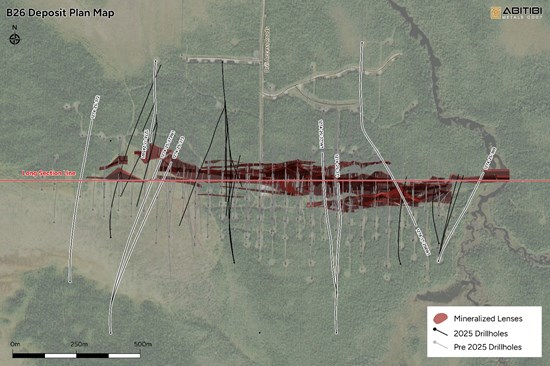
Figure 1: Plan Map
To view an enhanced version of this graphic, please visit:
https://images.newsfilecorp.com/files/11775/272535_f64b8d8dc4f82b70_001full.jpg
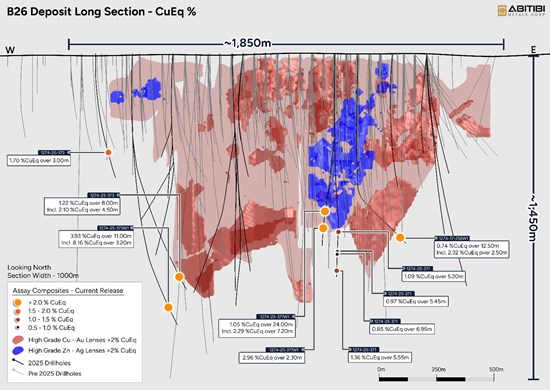
Figure 2: Longitudinal section looking north with Significant Results from Phase 3 drill program
To view an enhanced version of this graphic, please visit:
https://images.newsfilecorp.com/files/11775/272535_f64b8d8dc4f82b70_002full.jpg

Figure 3: Core picture 3.93% CuEq over 11 metres from 1,282m to 1,293m in hole 1274-25-373W1
To view an enhanced version of this graphic, please visit:
https://images.newsfilecorp.com/files/11775/272535_f64b8d8dc4f82b70_003full.jpg
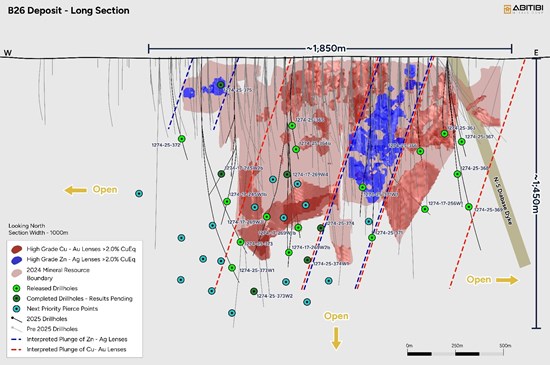
Figure 4: B26 Drill Program Update Ongoing 20,000m+ Phase 3
To view an enhanced version of this graphic, please visit:
https://images.newsfilecorp.com/files/11775/272535_f64b8d8dc4f82b70_004full.jpg
Table 2: Phase 3 Drill Hole Information
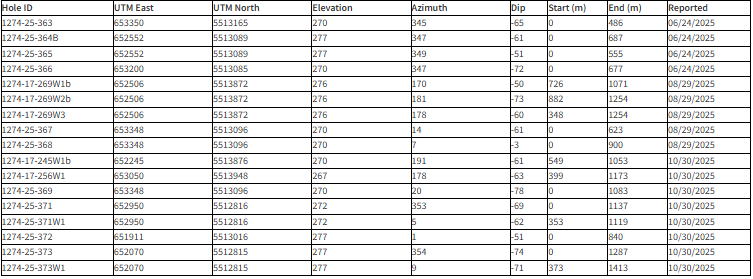
Note 1: Numbers have been rounded to the nearest whole number in the table above
QAQC
The core logging and QAQC protocol program was run and supervised by the Company technical team. The drill core was split in half, sent to AGAT Laboratories Ltd. All sample preparation takes place in Val-d’Or, all fire assay takes place in Thunder Bay and all four acid digestion and multi element analysis takes place in Calgary. Prepared samples are fused using accepted fire assay techniques, cupelled and parted in nitric acid and hydrochloric acid. Sample splits of 30g are routinely used though 50g may also be used (AGAT Code 202 551). 0.2g of prepared samples are digested with a series of acids (HClO4, HF, HCL and HNO3) at a temperature of ~200oC until incipient dryness. It is then heated with HNO3 and HCl, then diluted to 12mL with de-ionized water. While very aggressive, the solubility of some elements can be dependent on the mineral species present and as such, data reported from the 4-Acid digestion should be considered as representing only the leachable portion of a particular analyte. Some elements show poor recovery due to volatilization (B, As, Hg). PerkinElmer 7300DV/8300DV ICP-OES and Agilent 5900 ICP-OES instruments are used in the analysis. Inter-Element Correction (IEC) techniques are used to correct for any spectral interferences. Blanks, sample replicates, duplicates, and internal reference materials (both aqueous and geochemical standards) are routinely used as part of AGAT Laboratories quality assurance program. AAS instruments are used in the analysis.
Qualified Person
Information contained in this press release was reviewed and approved by Louis Gariépy, P.Eng (OIQ #107538), VP Exploration of Abitibi Metals, who is a qualified person as defined under National Instrument 43-101, and responsible for the technical information provided in this news release.
About Abitibi Metals Corp:
Abitibi Metals Corp. (CSE: AMQ) is a Quebec-focused mineral acquisition and exploration company focused on the development of quality base and precious metal properties that are drill-ready with high-upside and expansion potential. Abitibi’s portfolio of strategic properties provides target-rich diversification and includes the option to earn 80% of the high-grade B26 Polymetallic Deposit, which hosts a resource estimate1 of 11.3MT @ 2.13% Cu Eq (Ind- 1.23% Cu, 1.27% Zn, 0.46 g/t Au and 31.9 g/t Ag) & 7.2MT @ 2.21% Cu Eq (Inf – 1.56% Cu, 0.17% Zn, 0.87 g/t Au and 7.4 g/t Ag), and the Beschefer Gold Project, where historical drilling has identified 4 historical intercepts with a metal factor of over 100 g/t gold highlighted by 55.63 g/t gold over 5.57 metres (BE13-038) and 13.07 g/t gold over 8.75 metres (BE12-014) amongst four modeled zones.
About SOQUEM:
SOQUEM, a mineral exploration company and subsidiary of Investissement Québec, is dedicated to promoting the exploration, discovery and development of mining properties in Quebec. SOQUEM also contributes to maintaining strong local economies. Proud partner and ambassador for the development of Quebec’s mineral wealth, SOQUEM relies on innovation, research and strategic minerals to be well-positioned for the future.
ON BEHALF OF THE BOARD
Jonathon Deluce, Chief Executive Officer
For more information, please call +1-226-271-5170, email info@abitibimetals.com, or visit https://www.abitibimetals.com.
The Company also maintains an active presence on various social media platforms to keep stakeholders and the general public informed and encourages shareholders and interested parties to follow and engage with the Company through the following channels to stay updated with the latest news, industry insights, and corporate announcements:
Twitter: https://twitter.com/AbitibiMetals
LinkedIn: https://www.linkedin.com/company/abitibi-metals-corp-amq-c/
Neither the Canadian Securities Exchange nor its Regulation Services Provider accepts responsibility for the adequacy or accuracy of this release.
Note 1: Technical Report NI 43-101 Resource Estimation Update Project B26, Quebec, For Abitibi Metals Corp., By SGS Canada Inc., Yann Camus, ing., Olivier Vadnais-Leblanc, géo., SGS Canada – Geostat., Effective Date: November 1, 2024, Date of Report: February 26, 2025
Forward-looking statement:
This news release contains certain statements, which may constitute “forward-looking information” within the meaning of applicable securities laws. Forward-looking information involves statements that are not based on historical information but rather relate to future operations, strategies, financial results or other developments on the B26 Project or otherwise. Forward-looking information is necessarily based upon estimates and assumptions, which are inherently subject to significant business, economic and competitive uncertainties and contingencies, many of which are beyond the Company’s control and many of which, regarding future business decisions, are subject to change. These uncertainties and contingencies can affect actual results and could cause actual results to differ materially from those expressed in any forward-looking statements made by or on the Company’s behalf. Although Abitibi has attempted to identify important factors that could cause actual actions, events or results to differ materially from those described in forward-looking information, there may be other factors that cause actions, events or results to differ from those anticipated, estimated or intended. All factors should be considered carefully, and readers should not place undue reliance on Abitibi’s forward-looking information. Generally, forward-looking information can be identified by the use of forward-looking terminology such as “expects,” “estimates,” “anticipates,” or variations of such words and phrases (including negative and grammatical variations) or statements that certain actions, events or results “may,” “could,” “might” or “occur. Mineral exploration and development are highly speculative and are characterized by a number of significant inherent risks, which may result in the inability of the Company to successfully develop current or proposed projects for commercial, technical, political, regulatory or financial reasons, or if successfully developed, may not remain economically viable for their mine life owing to any of the foregoing reasons, among others. There is no assurance that the Company will be successful in achieving commercial mineral production and the likelihood of success must be considered in light of the stage of operations.
Featured Image @ Freepik







